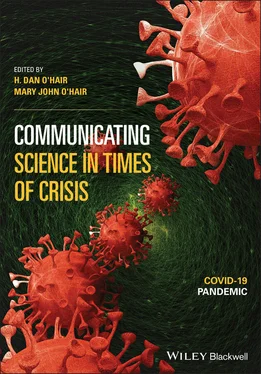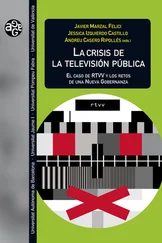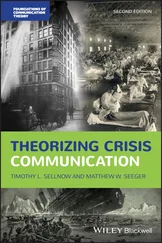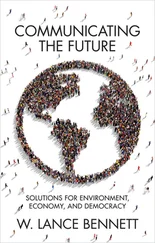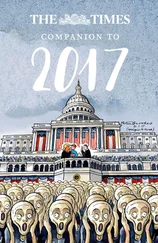57 Douglas, K. M., Sutton, R. M., Callan, M. J., Dawtry, R. J., & Harvey, A. J. (2016). Someone is pulling the strings: Hypersensitive agency detection and belief in conspiracy theories. Thinking & Reasoning, 22(1), 57–77. https://doi.org/10.1080/13546783.2015.1051586
58 Douglas, K. M., Uscinski, J. E., Sutton, R. M., Cichocka, A., Nefes, T., Ang, C. S., & Deravi, F. (2019). Understanding conspiracy theories. Advances in Political Psychology, 40(suppl. 1), 3–35. https://doi.org/10.1111/pops.12568
59 Drinkwater, K. G., Dagnall, N., Denovan, A., & Neave, N. (2020). Psychometric assessment of the generic conspiracist beliefs scale. PLoS ONE, 15(3), 1–19. https://doi.org/10.1371/journal.pone.0230365
60 Durodolu, O. O., & Ibenne, S. K. (2020, June). The fake news infodemic vs information literacy. Library Hi Tech, 37(7), 13–14. https://doi.org/10.1108/LHTN-03-2020-0020
61 Edy, J. A., & Risley-Baird, E. E. (2016a). Misperceptions as political conflict: Using Schattschneider’s conflict theory to understand rumor dynamics. International Journal of Communication, 10, 2596–2615. https://ijoc.org/index.php/ijoc/article/view/4430/1668
62 Edy, J. A., & Risley-Baird, E. E. (2016b). Rumor communities: The social dimensions of internet political misperceptions. Social Science Quarterly, 97(3), 588–602. https://doi.org/10.1111/ssqu.12309
63 Effron, D. A., & Raj, M. (2020). Misinformation and morality: Encountering fake-news headlines makes them seem less unethical to publish and share. Psychological Science (0956-7976), 31(1), 75–87. https://doi.org/10.1177/0956797619887896
64 Ekman, P., & O’Sullivan, M. (2006). From flawed self-assessment to blatant whoppers: The utility of voluntary and involuntary behavior in detecting deception. Behavioral Sciences & the Law, 24(5), 673–686. https://doi.org/10.1002/bsl.729
65 Enders, A. M., & Smallpage, S. M. (2019). Informational cues, partisan-motivated reasoning, and the manipulation of conspiracy beliefs. Political Communication, 36(1), 83–102. https://doi.org/10.1080/10584609.2018.1493006
66 Erat, S., & Gneezy, U. (2012). White lies. Management Science, 58(4), 723–733. https://doi.org/10.1287/mnsc.1110.1449
67 Fasce, A., & Picó, A. (2019a). Conceptual foundations and validation of the Pseudoscientific Belief Scale. Applied Cognitive Psychology, 33(4), 617–628. https://doi.org/10.1002/acp.3501
68 Fasce, A., & Picó, A. (2019b). Science as a vaccine: The relation between scientific literacy and unwarranted beliefs. Science & Education, 28(1–2), 109–125. https://doi.org/10.1007/s11191-018-00022-0
69 Ferrara, E. (2020a). #COVID-19 on Twitter: Bots, conspiracies, and social media activism. arXiv preprint. https://arxiv.org/ct?url=https%3A%2F%2Fdx.doi.org%2F10.5210%2Ffm.v25i6.10633&v=da141594
70 Ferrara, E. (2020b). What types of COVID-19 conspiracies are populated by Twitter bots? First Monday, 25(6). https://doi.org/10.5210/fm.v25i6.10633
71 Ferrara, E., Varol, O., Davis, C., Menczer, F., & Flammini, A. (2016). The rise of social bots. Communications of the ACM, 59(7), 96–104. https://doi.org/10.1145/2818717
72 Ferreira, C. C., Robertson, J., & Kirsten, M. (2020). The truth (as I see it): Philosophical considerations influencing a typology of fake news. Journal of Product & Brand Management, 29(2), 150–158. https://doi.org/10.1108/JPBM-12-2018-2149
73 Feyerabend, P. (1980). How to defend society against science. In E. D. Klemke, R. Hollinger, & A. D. Kline (Eds.), Introductory readings in the philosophy of science (pp. 55–65). Prometheus.
74 Finley, T., & Koyama, M. (2018). Plague, politics, and pogroms: The Black Death, the rule of law, and the persecution of Jews in the Holy Roman Empire. Journal of Law & Economics, 61(2), 253–277. https://doi.org/10.1086/699016
75 Fisher, W. R. (1980). Rationality and the logic of good reasons. Philosophy & Rhetoric, 13(2), 121–130. https://www.jstor.org/stable/40237140
76 Fisher, W. R. (1985a). The narrative paradigm: An elaboration. Communication Monographs, 52(4), 347–367. https://doi.org/10.1080/03637758509376117
77 Fisher, W. R. (1985b). The narrative paradigm: In the beginning. Journal of Communication, 35(4), 74–89. https://doi.org/10.1111/j.1460-2466.1985.tb02974.x
78 Flack, J. C., & de Waal, F. (2007). Context modulates signal meaning in primate communication. Proceedings of the National Academy of Sciences of the United States of America, 104(5), 1581–1586. https://doi.org/10.1073/pnas.0603565104
79 Franks, B., Bangerter, A., & Bauer, M. W. (2013, July). Conspiracy theories as quasireligious mentality: An integrated account from cognitive science, social representations theory, and frame theory. Frontiers in Psychology, 4, 424. https://doi.org/10.3389/fpsyg.2013.00424
80 Franks, B., Bangerter, A., Bauer, M. W., Hall, M., & Noort, M. C. (2017, June). Beyond “monologicality”? exploring conspiracist worldviews. Frontiers in Psychology, 8, 861. https://doi.org/10.3389/fpsyg.2017.00861
81 Freeman, D., Waite, F., Rosebrock, L., Petit, A., Causier, C., East, A., Jenner, L., Teale, A.-L., Carr, L., Mulhall, S., Bold, E., & Lambe, S. (2020a). Coronavirus conspiracy beliefs, mistrust, and compliance with government guidelines in England. Psychological Medicine. Online first. https://doi.org/10.1017/S0033291720001890
82 Freeman, D., Waite, F., Rosebrock, L., Petit, A., Causier, C., East, A., Jenner, L., Teale, A.-L., Carr, L., Mulhall, S., Bold, E., & Lambe, S. (2020b). We should beware of ignoring uncomfortable possible truths (a reply to McManus et al). Psychological Medicine. Online first. https://doi.org/10.1017/S0033291720002196
83 Gallotti, R., Sacco, P. L., & De Domenico, M. (2020). Assessing the risks of “infodemics” in response to COVID-19 epidemics. Nature Human Behavior, 4, 1285–1293. https://doi.org/10.1101/2020.04.08.20057968
84 Gámez-Guadix, M., Almendros, C., Calvete, E., & De Santisteban, P. (2018, February). Persuasion strategies and sexual solicitations and interactions in online sexual grooming of adolescents: Modeling direct and indirect pathways. Journal of Adolescence, 63, 11–18. https://doi.org/10.1016/j.adolescence.2017.12.002
85 Garrett, B., Murphy, S., Jamal, S., MacPhee, M., Reardon, J., Cheung, W., Mallia, E., & Jackson, C. (2019). Internet health scams—Developing a taxonomy and risk‐of‐deception assessment tool. Health & Social Care in the Community, 27(1), 226–240. https://doi.org/10.1111/hsc.12643
86 Gebauer, F., Raab, M. H., & Carbon, C. (2016). Conspiracy formation is in the detail: On the interaction of conspiratorial predispositions and semantic cues. Applied Cognitive Psychology, 30(6), 917–924. https://doi.org/10.1002/acp.3279
87 Geschke, D., Lorenz, J., & Holtz, P. (2019). The triple‐filter bubble: Using agent‐based modelling to test a meta‐theoretical framework for the emergence of filter bubbles and echo chambers. British Journal of Social Psychology, 58(1), 129–149. https://doi.org/10.1111/bjso.12286
88 Giglietto, F., Iannelli, L., Valeriani, A., & Rossi, L. (2019). “Fake news” is the invention of a liar: How false information circulates within the hybrid news system. Current Sociology, 67(4), 625–642. https://doi.org/10.1177/0011392119837536
89 Goertzel, T. (1994). Belief in conspiracy theories. Political Psychology, 15(4), 733–744. https://doi.org/10.2307/3791630
90 Goreis, A. & Voracek, M. (2019, February). A systematic review and meta-analysis of psychological research on conspiracy beliefs: Field characteristics, measurement instruments, and associations with personality traits. Frontiers in Psychology, 10, 1–13. https://doi.org/10.3389/fpsyg.2019.00205
91 Graham, T., Bruns, A., Zhu, G., & Campbell, R. (2020, May). Like a virus: The coordinated spread of coronavirus disinformation. Australia Institute. https://apo.org.au/sites/default/files/resource-files/2020-06/apo-nid305864.pdf
Читать дальше
